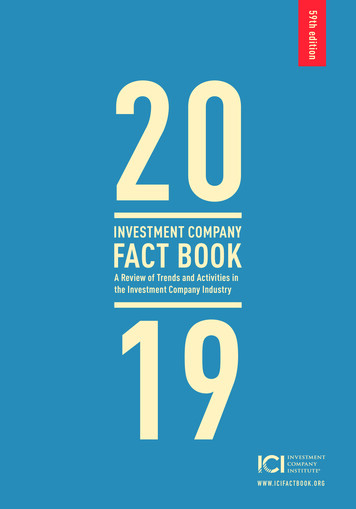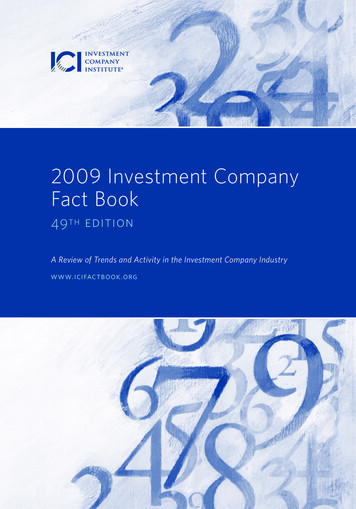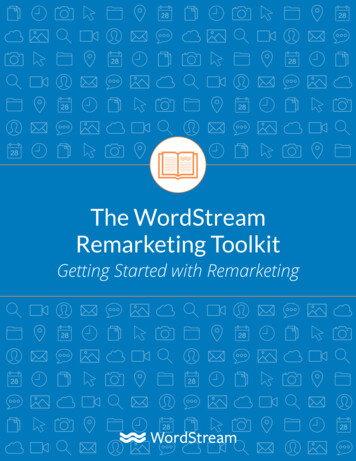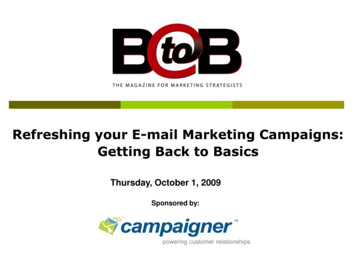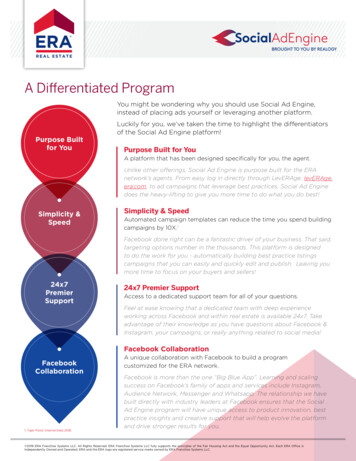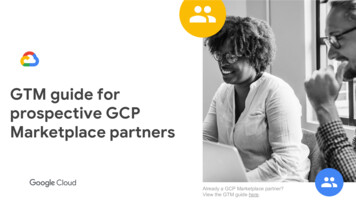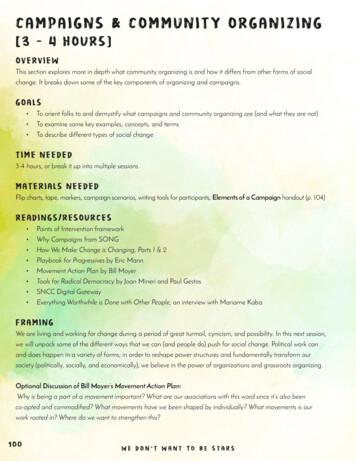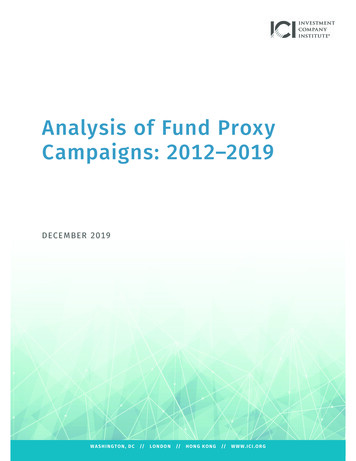
Transcription
Analysis of Fund ProxyCampaigns: 2012–2019DEC E MB ER 2019WA SHINGTON, DC//LONDON//HONG KONG//W W W.ICI.ORG
The Investment Company Institute (ICI) is the leading association representing regulated funds globally, including mutualfunds, exchange-traded funds (ETFs), closed-end funds, and unit investment trusts (UITs) in the United States, and similar fundsoffered to investors in jurisdictions worldwide. ICI seeks to encourage adherence to high ethical standards, promote publicunderstanding, and otherwise advance the interests of funds, their shareholders, directors, and advisers.The content contained in this document is proprietary property of ICI and should not be reproduced or disseminated withoutICI’s prior consent.Copyright 2019 by the Investment Company Institute. All rights reserved.
Analysis of Fund Proxy Campaigns:2012–2019Matthew Thornton, Assistant General Counsel; Dorothy Donohue, Deputy General Counsel; SusanOlson, General Counsel; Joanne Kane, Director, Transfer Agency and Operations; James Duvall,Associate Economist; and Casey Rybak, Research Assistant; prepared this report.Contents1I. Executive Summary4II. Background and Description of ICI’s Proxy Recommendations8III. Description of Survey9IV. Key Findings from Survey and Member Outreach9A. Obtaining Shareholder Approval Is Often Difficult and Costly16B. The Proxy System’s High Costs and Challenges Are Disproportionately AffectingDecisions Related to Fund Policies, Governance, and Operations22C. Voting Shareholders Strongly Support 1940 Act Majority Items25D. Most Funds Would Benefit from ICI’s Supermajority Recommendation26E. Additional Cost Savings from ICI’s Other RecommendationsA1 Appendix A: ICI’s Supermajority Recommendation ExplainedB1 Appendix B: Relevant Delaware, Massachusetts, and Maryland Business EntityProvisions
Analysis of Fund Proxy Campaigns:2012–2019I. Executive SummaryMultiple legal and regulatory provisions govern the shareholder meeting and approvalrequirements for registered investment companies (“funds”), including the InvestmentCompany Act of 1940 (“1940 Act”). The 1940 Act and certain rules thereunder require the“vote of a majority of the outstanding voting securities of a company” (“1940 Act Majority”)to approve several specified items, including changes to fundamental investment policies,investment advisory and distribution agreements, Rule 12b-1 plans, and mergers ofaffiliated funds (collectively, “1940 Act Majority Items”). The 1940 Act Majority standardrequires funds to obtain a quorum of greater than 50 percent to approve these Items.Fund shareholders also vote on nominees to the fund board and other matters, with theserequirements more strongly shaped by state law and the terms of the funds’ organizationaldocuments.Funds face unique and daunting challenges when seeking to obtain quorum andshareholder approvals, primarily due to:» Funds’ diffuse and retail-oriented shareholder bases;» Retail shareholders’ relatively low proxy participation rates; and» Severe and costly impediments that limit funds’ ability to communicate directly withtheir shareholders.ICI’s June 2019 letter to the SEC detailed these challenges and offered severalrecommendations for improving the fund proxy system.1 Most notably, we recommendedcreating a new third way—to complement the existing statutory ways—for a fund to approve1940 Act Majority Items. Compared to the statutory methods, ICI’s recommendationcouples a lower quorum requirement (more than 331/3 percent) with a higher affirmativevote requirement (at least 75 percent) (the “Supermajority Recommendation”).Following that June Letter, ICI conducted a member survey on funds’ proxy experiencesover the past seven years. The survey was designed to provide more granular informationabout funds’ 1940 Act Majority Items; the costs of their related proxy campaigns; and theanticipated effects of ICI’s Supermajority Recommendation.1See Letter from Paul Schott Stevens, President and CEO, ICI, to Ms. Vanessa Countryman, Acting Secretary, SEC,dated June 11, 2019 (“June Letter”), available at .ANALYSIS OF FUND PROX Y C AMPAIGNS: 2012–2019 // 1
Sixty-four ICI member firms responded, representing over 18 trillion, or approximately76 percent, of US-registered fund assets. The survey results illustrate the importance ofreform and how ICI’s recommendations would benefit funds and their shareholders. Morespecifically, the results demonstrate that:» Funds are experiencing significant costs and challenges when seeking shareholderapprovals.» Cost estimates for 145 separate campaigns totaled 373 million.» Twenty-two campaigns had costs greater than or equal to 1 million.» Eight had costs greater than or equal to 10 million.» The most expensive campaign was 107 million.» This 373 million total understates industrywide proxy costs because:» Not all fund complexes completed the survey.» Of those that did, the survey did not capture all of respondents’ proxy costsover this period (respondents provided information limited to five 1940Act Majority Items and their related campaigns, and did not provide costinformation for campaigns consisting solely of non-1940 Act Majority Items,such as director elections).» Most respondents did not report internal proxy campaign costs (e.g.,personnel time spent preparing proxy materials, assisting with solicitationstrategy, providing in-house legal assistance, and overseeing andcoordinating efforts with third parties).» Thirty-eight percent of reported proposals required at least one meetingadjournment to reach quorum, meaning that the affected fund(s) had toreconvene the meeting at a later date (in some cases, multiple times) to resolvethe proxy matter.» The proxy system’s high costs and challenges are disproportionately affectingdecisions related to fund policies, governance, and operations.» Seventy-seven percent of respondents indicated that they would considerchanging at least one of their funds’ existing fundamental policies if they coulddo so with board approval and advance shareholder notice in lieu of a proxy.» Forty percent indicated that the proxy process impeded the fund complex’sdecision, including how and when, to add new board members.» Thirty-six percent indicated that the costs of the proxy process had led themto liquidate funds in lieu of other alternatives (e.g., a shareholder-approvedmerger).» Fifty percent indicated that the high costs of the proxy process deterred the fairconsideration of other beneficial actions.2 // ANALYSIS OF FUND PROX Y C AMPAIGNS: 2012–2019
» ICI’s Supermajority Recommendation would significantly reduce overall proxycampaign costs, by greatly reducing follow-up solicitation costs.» Of the 373 million in total proxy campaign costs, the high-end estimate offollow-up solicitation costs was 229 million (or 61 percent of total campaigncosts), and the low-end estimate was 158 million (or 42 percent of totalcampaign costs).» Voting shareholders overwhelmingly support funds’ proxy proposals, underscoringthat the fund proxy system itself—not the nature of the proposals—drives thesecosts and challenges for funds.» Despite funds’ challenges in reaching quorum (which funds sometimesovercome only by spending significant money and using internal resources), fundshareholders ultimately approve 95 percent of 1940 Act Majority Items.» Voting shareholders strongly favor 1940 Act Majority Items by wide margins,with an average of 85 percent of shares represented at shareholder meetingsvoting “for” these Items. Excluding abstentions and broker non-votes, theaverage percentage of votes cast “for” these Items jumps to 94 percent.» Nearly 85 percent of funds would benefit from ICI’s Supermajority Recommendationbecause the quorum requirements in most funds’ organizational documents areconsistent with the Recommendation. Furthermore, ICI’s Recommendation isconsistent with the laws of Delaware, Massachusetts, and Maryland—the states inwhich 94 percent of funds are organized and operate.Finally, additional cost savings would be realized for funds and their shareholders if the SECwere to follow ICI’s other recommendations to:» Permit funds greater freedom to link in proxy statements to more extensiveinformation;» Reform processing fees; and» Create alternative means for funds to change fundamental policies or hire subadvisers without shareholder approval.ANALYSIS OF FUND PROX Y C AMPAIGNS: 2012–2019 // 3
II. Background and Description of ICI’s ProxyRecommendationsMultiple legal and regulatory provisions govern funds’ shareholder meeting and approvalrequirements,2 including the 1940 Act. The 1940 Act and certain rules thereunder require a1940 Act Majority3 to approve:» Changes to fundamental investment policies;» Investment advisory and principal underwriting agreements (or amendmentsthereto);» Certain distribution arrangements (so-called “Rule 12b-1” plans) (or amendmentsthereto); and» Mergers of affiliated funds (collectively, “1940 Act Majority Items”).4Fund shareholders also vote on nominees to the fund board.5 Apart from what the 1940 Actrequires, other potential changes (e.g., amendments to a fund’s organizational documents)also may require shareholder approval, as set forth under state law, applicable listingstandards (e.g., for ETFs and closed-end funds), and a fund’s organizational documents.Funds face daunting challenges when seeking to obtain quorum and shareholder approvals,primarily because:» Funds have diffuse and retail-oriented shareholder bases.» Collectively, funds have over 100 million shareholders.6» Retail investors (i.e., households) held the vast majority (89 percent) of the 17.7trillion in mutual fund total net assets at year-end 2018.72These include state law, provisions of a fund’s organizational documents, and/or listing standards, ifapplicable.3Section 2(a)(42) defines this as “the vote, at the annual or a special meeting of the security holders of suchcompany duly called, (A) of 67 per centum or more of the voting securities present at such meeting, if theholders of more than 50 per centum of the outstanding voting securities of such company are presentor represented by proxy; or (B) of more than 50 per centum of the outstanding voting securities of suchcompany, whichever is the less.” Funds generally obtain approvals by achieving at least 67 percent supportfrom greater than 50 percent of shares outstanding, and unless otherwise noted, we focus on that approvalmethod in this report.41940 Act Sections 13(a), 15(a) and (b), and Rule 12b-1(b)(1) and Rule 17a-8 thereunder, respectively. Rule17a-8 (mergers of affiliated investment companies) requires the merging fund’s shareholders to approve themerger with a 1940 Act Majority unless the proposed transactions satisfies several conditions.5Section 16(a) of the 1940 Act requires shareholder approval of at least two-thirds of a fund’s directors.The Act also requires shareholders to ratify or reject a fund’s independent public accountant, althoughsubsequent rulemaking largely has obviated this requirement. See Section 32(a)(2) and Rule 32a-4thereunder, which exempts funds from this shareholder voting requirement, provided they satisfy certainaudit committee-related requirements.6Investment Company Institute. 2019. 2019 Investment Company Fact Book: A Review of Trends and Activities inthe Investment Company Industry, at 30, available at www.icifactbook.org.7Id. at 58. Mutual funds held as investments in individual retirement accounts, defined contribution retirementplans, variable annuities, 529 plans, and Coverdell education savings accounts are counted as householdholdings of mutual funds.4 // ANALYSIS OF FUND PROX Y C AMPAIGNS: 2012–2019
» Retail investors are far less likely to vote proxies than institutional investors.8» Over the past five years, shareholder voting trends have held steady for publiccompanies generally, with retail investors generally voting less than 30 percentof their shares (28 percent in 2019) and institutional shareholders votingapproximately 90 percent of their shares.9» Funds must overcome, at great expense, legal and other impediments tocommunicating directly with their shareholders.» Fund ownership is highly intermediated, and SEC rules prohibit funds fromcontacting directly their “objecting beneficial owners” (OBOs). This means that afund may not know the identities of a large percentage of its shareholders.» Individuals’ changing communication preferences generally make them harder toreach and less responsive once reached.» Federal law greatly impedes funds from contacting shareholders throughtheir cell phones (assuming funds have this information) unless theshareholder previously has consented to that form of contact.10» Together with shareholders’ transition to cell phones from landlines, it isharder for funds to reach their shareholders by phone (e.g., cell phone userstypically do not answer calls from unknown numbers).» Even when shareholders answer, they are much more skeptical (e.g., manybelieve that calls from unknown entities such as proxy solicitors are scams).These factors contribute significantly to the costs and effort required to seek and obtainshareholder approvals for fund matters. Our June Letter highlighted these challenges inmore detail, buttressed with public data and a 2018 member survey on proxy voting.118See generally Statement Announcing SEC Staff Roundtable on the Proxy Process, SEC Chairman Jay Clayton(July 30, 2018), available at , 2019 Proxy Season Review, at 5, available at www.broadridge.com/ See Telephone Consumer Protection Act of 1991 (“TCPA”), 47 U.S.C. § 227. The TCPA generally prohibits the useof certain kinds of automated dialing equipment (“robo-calling”) to call or text wireless telephone numbersabsent advance consent.11June Letter at 2-6. The June Letter summarized results from ICI’s 2018 survey on fund proxy campaigns.Compared to our Fall 2019 survey, however, the 2018 survey asked generally about all recent proxy campaigns(including those relating to recurring items like director elections) occurring in 2017 and 2018.ANALYSIS OF FUND PROX Y C AMPAIGNS: 2012–2019 // 5
To address these intractable difficulties, our June Letter recommended that the SEC:» Reevaluate the 1940 Act’s shareholder approval requirements, particularly forthose 1940 Act Majority Items where safeguards other than shareholder votingwould protect investors’ interests at a lower cost. For instance, funds should bepermitted to:» Change fundamental policies12 that are not material to a fund’s investmentstrategies or risks, subject to board approval and advance shareholder notice;and» Hire sub-advisers, subject to the types of conditions in the SEC’s “manager ofmanagers” exemptive relief.» Use its exemptive authority to create a new third way—to complement the existingtwo statutory ways—for a fund to approve remaining 1940 Act Majority Items.13» Revise proxy disclosure requirements to permit greater use of layering and linkingin proxy statements, which would make materials more readable and reduceprinting and mailing costs for multi-fund proxy statements in particular.Notably, subsequent to that Letter, a large broker-dealer announced that it would no longervote its customers’ shares on a discretionary basis, making the need for regulatory reformmore pressing.NYSE Rule 452 permits NYSE members to vote customers’ shares without customerinstruction for “routine” matters including funds’ director elections,14 but does not permitmembers to vote customers’ shares for any “non-routine” matters (including all 1940 ActMajority Items) without instruction. Broker discretionary voting is a critical tool for routineand non-routine proposals alike:» For routine proposals, these broker votes (which may be cast “for” a proposal) helpfunds achieve quorum and shareholder approvals.» For non-routine proposals, broker participation still is helpful, even though thebroker does not vote “for” or “against” such matters, but rather submits “nonvotes” for them. Non-routine items are sometimes paired with routine itemswithin a single fund proxy campaign. For such a campaign, broker voting on anyroutine matter helps a fund achieve quorum at the shareholder meeting, which is12Section 13(a) of the 1940 Act states that no fund shall, unless authorized by the vote of a majority of itsoutstanding voting securities, (i) change its subclassification as an open-end or closed-end fund, or itssubclassification from a diversified to a non-diversified company; (ii) borrow money, issue senior securities,underwrite securities issued by other persons, purchase or sell real estate or commodities or make loansto other persons, except in each case in accordance with the recitals of policy contained in its registrationstatement in respect thereto; (iii) deviate from its industry concentration policy as recited in its registrationstatement, deviate from any investment policy which is changeable only if authorized by shareholder vote,or deviate from any policy recited in its registration statement pursuant to Section 8(b)(3); or (iv) change thenature of its business so as to cease to be an investment company.13Compared to the statutory approval methods, we recommend a new method that couples a lower quorumrequirement (more than 331/3 percent) with a higher affirmative vote requirement (at least 75 percent).Appendix A explains this Supermajority Recommendation in greater detail.14This is referred to as “discretionary voting.”6 // ANALYSIS OF FUND PROX Y C AMPAIGNS: 2012–2019
a necessary prerequisite for achieving approval of non-routine items as well. Inthose circumstances, customers’ shares are present at the meeting, irrespective ofwhether the broker voted on all proposals at that meeting.15This one large broker’s decision not to vote will affect funds differently, based on thenumber of beneficial owners that hold fund shares through that broker. Yet if other brokers(especially larger brokers) follow this large broker’s lead and choose not to exercise theirdiscretionary voting authority (or are acquired by brokers with more restrictive proxy votingpractices), the utility of this tool will be seriously undermined.16 There also would seemto be economic logic to such a decision, as it would seem to eliminate any administrativecosts or burdens associated with discretionary voting. This approach in turn will increasethe time and cost—and in some cases, adversely affect funds’ basic ability—to electdirectors and approve other items.Brokers are not the only intermediaries whose inaction may adversely affect fundproxy campaigns. Our members report difficulties in obtaining proxy participation fromretirement plans, which are often large holders of mutual fund shares. By default, theduty to vote such proxies lies with the plan trustee or named fiduciary, although this dutycan be delegated to investment managers.17 Many defined contribution plans—throughthe plan document—pass the proxy voting responsibility to the plan’s participants. Whereplan participants hold voting rights, funds’ challenges are similar to those presented byretail investors generally (i.e., their voting participation rates are relatively low). When planfiduciaries assume the duty to vote proxies, additional considerations can dissuade themfrom voting.18Finally, there is little reason to believe that the relatively low proxy participation rateamong funds’ retail shareholders will rebound any time soon. One member recentlyconducted a proxy campaign for its target date funds, featuring a 1940 Act MajorityItem. Target date funds are unique in that they are heavily retail-owned, and those retailinvestors self-sort by age depending on their anticipated retirement dates (e.g., oldershareholders may invest in “2020” funds, while younger shareholders may invest in “2050”funds). Thus, proxy campaigns for target date funds provide interesting insights into votingbehavior. In this case, proxy participation rates were lower for those funds with younger15See Appendix A for a description of broker non-votes and how they affect 1940 Act Majority votes.16Most fund shares are held through intermediaries. If brokers choose not to vote on routine items like directorelections, funds would have to increase their follow-up solicitations of beneficial shareholders to reachquorum, adding delay and cost to proxy solicitations. See generally Costs of Eliminating Discretionary BrokerVoting on Uncontested Elections of Investment Company Directors (Dec. 18, 2006), available at www.ici.org/pdf/wht broker voting.pdf.17Interpretive Bulletin Relating to the Exercise of Shareholder Rights and Written Statements of InvestmentPolicy, Including Proxy Voting Policies or Guidelines, DOL Interpretive Bulletin 2016-01, 81 Fed. Reg. 95879(Dec. 29, 2016)(“DOL IB 2016-01”).18According to DOL IB 2016-01, plan fiduciaries are generally required “to vote proxies on issues that may affectthe value of the plan’s investment” but also give consideration to whether the plan’s vote “is expected to havean effect on the value of the plan’s investment that warrants the additional cost of voting.” Therefore, the lackof voting that our members report may be the result of the legitimate belief of plan fiduciaries that the votewill not affect the value of the fund, or that the efforts that would be required to determine which vote is inthe best interests of the plan participants would not merit the cost.ANALYSIS OF FUND PROX Y C AMPAIGNS: 2012–2019 // 7
shareholders. While most of the target date funds designed for investors who were pasttheir target retirement dates reached quorum with a single round of proxy solicitation,target date funds designed for much younger investors (i.e., those with target retirementdates of 2050 and beyond) required multiple additional solicitations to reach quorum.Such behavior may be affected by several factors, including age, asset balances, andemployment status/proximity to retirement. This example portends that today’s overall lowretail voting rate likely does not represent a floor.III. Description of SurveyICI’s Fall 2019 member survey asked specifically about 1940 Act Majority Items on whichshareholders voted over the past seven years. Sixty-four ICI member firms responded,representing over 18 trillion, or approximately 76 percent of US-registered fund assets, asof June 30, 2019. The survey asked respondents to provide data regarding:» Total costs of proxy campaigns that included at least one 1940 Act Majority Item(145 total campaigns),19 and the estimated percentages of these totals attributableto follow-up solicitations (e.g., costs associated with follow-up mailings, emails, andphone calls);» The impact that ICI’s Supermajority Recommendation would have had on thosecampaigns;» The effects of the fund proxy process (including its costs and challenges) on fundpolicies, governance, and fund liquidations;» Specific 1940 Act Majority Items on which shareholders voted (e.g., ultimateoutcomes and degree of support) over the past seven years (208 total Items);20 and» The default minimum quorum requirement for shareholder meetings in funds’organizational documents.The reported proxy costs understate industrywide proxy costs over the past seven yearsbecause:» Not all fund complexes completed the survey.» Of those that did, the survey did not capture all of respondents’ proxy costs overthis period:» To reduce the survey’s burden, we asked respondents to provide informationlimited to five 1940 Act Majority Items and their related campaigns, which forsome respondents represented only a portion of their proxy activity during thatperiod; and19The number of campaigns is smaller than the number of 1940 Act Majority Items because some campaignshad multiple Items.20Most respondents provided complete information for the requested Items (including the related costinformation), although in a few cases respondents did not (we note such cases in this report).8 // ANALYSIS OF FUND PROX Y C AMPAIGNS: 2012–2019
» Our survey did not capture cost information for proxy campaigns consistingsolely of non-1940 Act Majority Items, such as director elections.» Most respondents did not report internal proxy campaign costs (e.g., personnel timespent preparing and delivering proxy materials, assisting with solicitation strategy,providing in-house legal assistance, and overseeing and coordinating efforts withthird parties such as outside counsel, proxy solicitors, and mail vendors) or therelated opportunity costs (e.g., diversion of resources that would have otherwisebeen employed elsewhere).We also conducted over 40 follow-up calls with individual members to better understandtheir proxy experiences. We summarize our key findings below.IV. Key Findings from Survey and Member OutreachSignificant challenges and costs accompany the fund proxy process. Typically, thesedifficulties arise not from insufficient support from those shareholders who vote (seeSection IV.C below), but from lack of overall and sufficiently prompt voting activity amongshareholders generally. In short, the significant effort needed to reach quorum often drivesthese costs and challenges.ICI’s Supermajority Recommendation would be broadly beneficial, with benefits scaling up(in both absolute dollars and percentages terms) for larger, more expensive campaigns,due to typically substantial follow-up solicitation efforts. ICI’s other recommendations inthe June Letter, if enacted, would further reduce costs.We present survey questions below in italics, followed by the survey results. We alsoinclude interpretative and explanatory information.A. Obtaining Shareholder Approval Is Often Difficult and Costly1. Delays in Reaching Quorum and Resolving Voting MattersQ1. Provide the number of related adjournments (if any) for each reported 1940 ActMajority Item.As indicated in Figure 1 below, a significant percentage—38 percent—of proposals requiredat least one adjournment, and some required multiple adjournments. When a shareholdermeeting adjourns, the affected fund(s) must reconvene the meeting at a later date (in somecases, multiple times) to resolve the proxy matter.Of course, adjournment statistics are only one measure of difficulty. They do not accountfor the costs of funds or advisers committing additional money and other resources tosecure a timely quorum and avoid adjournments and the uncertainty that they bring.Nevertheless, these numbers suggest that despite such efforts, adjournments are common.ANALYSIS OF FUND PROX Y C AMPAIGNS: 2012–2019 // 9
FIGURE 1Thirty-Eight Percent of Proposals Required at Least One Adjournment to ReachQuorumPercentage of proposals20%One adjournment7%Two adjournments62%No adjournments11%Three or more adjournmentsNote: Data are based on survey responses representing 76 percent of US registered fund assets as ofJune 30, 2019.2. Overall Cost EstimatesQ2. For each reported 1940 Act Majority Item, provide the total cost of the related proxycampaign.Respondents provided cost estimates for 145 campaigns over the past seven years, withcosts totaling over 373 million.21» Twenty-two campaigns had costs greater than or equal to 1 million.» Eight campaigns had costs greater than or equal to 10 million.» Three campaigns had costs exceeding 50 million.» The highest reported campaign cost was 107 million.» Campaigns otherwise ranged in cost, with some totaling less than 100,000.The 107 million figure is not the all-time high for a fund proxy campaign. As part of ouroutreach, another member informed us that the total cost of its 2009 proxy campaign(outside the period of our survey) was nearly 136 million.21This 373 million total understates overall industry proxy costs. See supra, Section III.10 // ANALYSIS OF FUND PROX Y C AMPAIGNS: 2012–2019
In speaking with members reporting lower-cost campaigns (which included larger andsmaller fund complexes alike), certain commonalities emerged:» The campaigns were often limited in scope, (e.g., they may have included only asingle item for a single fund); and/or» The funds had shareholder bases requiring little or no follow-up solicitation,because they had one or more of the following:» Relatively large percentages of institutional investors, who are much more likelyto vote;» Relatively large percentages of shareholders that can, and do, “echo vote;”22» Greater knowledge of and visibility into the shareholder base, allowing moreefficient direct communications; and/or» Relatively concentrated shareholder bases (i.e., single shareholders holdinglarge percentages of a fund’s shares), where the large shareholders vote.Moreover, funds often know whether they have these factors in their favor, and they aremuch more likely to seek shareholder approval of items when their anticipated costs anddifficulties are more reasonable.We note that “cost” is a relative term—the size of a fund impacts how well it canbear costs of varying magnitudes. ICI’s Small Funds Committee members have beenparticularly engaged on these matters and vocal in their desire for reform.23 Even coststhat appear “low” in absolute terms can have an outsized effect on small funds and theirshareholders.24 Internal personnel at smaller complexes also are less able to absorb acampaign’s burdens. Finally, smaller funds may be subject to expense caps, meaning theadvisers will absorb a greater percentage of the costs.22This is a common feature of insurance-dedicated funds and fund of funds arrangements. “Echo” (or “mirror”)voting occurs when a fund shareholder votes all of its shares in the same proportion (e.g., “for” and “against”)as the vote of some or all of the other shareholders.23See, e.g., Letter from Neil J. Hennessy, Chairman, Chief Executive Officer, and Teresa
"vote of a majority of the outstanding voting securities of a company" ("1940 Act Majority") to approve several specified items, including changes to fundamental investment policies, investment advisory and distribution agreements, Rule 12b-1 plans, and mergers of affiliated funds (collectively, "1940 Act Majority Items").
